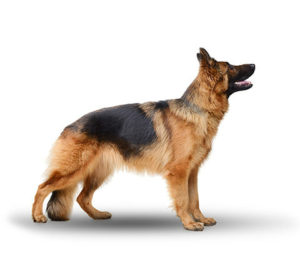Our family St. Bernard, Lacey, is one of the friendliest dogs you will ever come across, despite her impressive size and physical strength. She loves people and has a keen sense of smell, especially for food. Her excellent olfactory sense makes Lacey the best detector of the errant morsels that find their way from the kitchen counter or dinner table to the floor. Indeed, when it comes to finding anything edible, she is one of the best in the business.

Brandon Fried is the executive director of the U.S. Airforwarders Association
While most dogs like Lacey have good noses for finding food, it turns out that some also have a keen sense of smell for finding traces of chemicals used in explosive devices. Dogs inhale and exhale five times per second to breathe in a noseful of scents that are decoded instantly by about 300 million receptor cells. When trained by qualified professionals, using live explosives in the teaching process, these animals become a particularly useful means of ensuring the safety of air cargo. Their use should increase due to an industry program that allows U.S. Transportation Security Administration (TSA) oversight of private teams that perform the primary screening of airfreight.
The use of canines to detect explosives is not new – in fact, they have been used to prevent bombs from being introduced into transportation systems since 1972. The TSA has been using its explosive detection canines since 2008 to screen baggage, and since 2011 to screen passengers. These specially trained dogs have proven to be highly capable of detecting potential explosives by several U.S. government agencies and could play a critical role in ensuring air cargo is safe to fly.
In today’s dangerous world, air cargo screening has become as essential to global security as the screening of passengers. But as a practical matter, modern technology to screen large quantities of airfreight with speed necessary to satisfy the worldwide supply chain just does not exist and is unlikely to be available for many years. Therefore, the most efficient way of filling this gap is the low-tech use of canines trained to detect explosives for primary screening of air cargo, especially for high-risk freight.
Using third-party canines for airfreight screening would provide several commercial and safety enhancements. For example, dogs are particularly fast and efficient in screening large volumes of cargo. They can accurately screen shipments at the individual piece level and detect those loaded with pallets or containers. Some commodities and packaging configurations can be screened more effectively, more efficiently and less intrusively by the Laceys of this world than any of today’s cutting edge artificial scanning equipment.
The TSA has a force of more than 1,000 trained canine teams for use in the screening of both passengers and cargo, but the numbers are small and are today limited to the screening of travelers to reduce waiting times at passenger checkpoints. The only way to create the teams necessary to allow for the primary screening of air cargo is to have TSA establish standards, qualify third-party vendors and begin an ongoing audit program for the use of private, third-party-provided canines by the air cargo industry. The 2010 pilot project conducted by the TSA demonstrated that privately supplied canines could receive training to agency standards, so we know that the goal of using this method as a primary screening mode is achievable.
So far, the TSA has been slow to take the necessary steps to allow such a program to proceed despite the continuing recommendations of its Aviation Security Advisory Committee. However, there are signs of progress that the agency, notwithstanding the absence of political leadership, is advancing in establishing the initiative. Money could be causing the delay, since the TSA requires funding to provide appropriate oversight of third-party canine programs to ensure the meeting of TSA standards. Fortunately, $3.4 million for this program is in the fiscal year 2017 federal budget, but subsequent years will demand more funding, despite industry planning to pay for its certification and audit expenses.
 Recognition of a third-party canine program in the United States is overdue and would align U.S. regulations with common practices in the rest of the world. In the U.S., the value of using explosive detection canines is part of the Implementing Recommendations of the 9/11 Recommendations Act of 2007. The Government Accountability Office, theDepartment of Homeland Security’s Inspector General, and other independent testers have proven canine teams to be one of the most effective means of detecting explosive substances.
Recognition of a third-party canine program in the United States is overdue and would align U.S. regulations with common practices in the rest of the world. In the U.S., the value of using explosive detection canines is part of the Implementing Recommendations of the 9/11 Recommendations Act of 2007. The Government Accountability Office, theDepartment of Homeland Security’s Inspector General, and other independent testers have proven canine teams to be one of the most effective means of detecting explosive substances.
The air cargo industry has met, and continues to meet, the cargo screening mandate passed by the U.S. Congress almost a decade ago through extensive investments in equipment to perform the task. Now is the time to augment human-made technology with help from man’s best friend.

